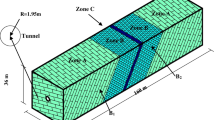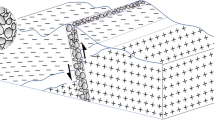Abstract
When the tunnel face is close to the fault, it will destroy the existing groundwater system and cause the surge of water in the tunnel face or roof. In order to determine the thickness of water inrush prevention safety, when the tunnel axis is orthogonal to fault, the outburst prevention model for face and roof water inrush model are constructed. Based on the Sheorey model and Silo theory, the stress state at the fault location is determined. Based on the limit equilibrium method, a theoretical formula of minimum safe thickness is derived, and the sensitivity analysis of parameters is carried out. Finally, it is verified by an engineering example. The results show that (1) the minimum safety thickness increases with the increase of the fault zone size, and the influence is negligible when the fault size exceeds the limit value; (2) the limit value of fault dip angle is determined when water gushes from roof or face; (3) the frictional resistance coefficients of the fault and surrounding rock have great influence on the minimum safety thickness, but the cohesive force of surrounding rock has little influence; (4) the minimum safety thickness increases with the increase of water pressure and tunnel diameter.



















Similar content being viewed by others
References
Bu W, Xu H (2020) Research on the effect of dip angle on shear stress on normal fault plane and water inrush in floor strata during mining activities [J]. Geotech Geol Eng 3
Fang Y, Hui-chao WANG, Chao-yue ZHOU et al (2017) Research on the tunnel face stability influenced by forward concealed cave with internal water pressure. Journal of Hunan University: Natural Sciences 44(09):137–145 (In Chinese)
Fu H, An P, Chen L, et al (2021) Analysis of tunnel water inrush considering the influence of surrounding rock permeability coefficient by excavation disturbance and ground stress. Applied Sciences-Basel 11(8):3645
Gan K-r, Yi YANG, Jian-she LI (2007) Analysis on karst water inflow mechanisms and determination of thickness of safe rock walls: case study on a tunnel. Tunnel Construction (3):13–16+50 (In Chinese)
Gao CL, Zhou ZQ, Yang WM, Lin CJ, Li LP, Wang J (2019) Model test and numerical simulation research of water leakage in operating tunnels passing through intersecting faults [J]. Tunn Undergr Space Technol 94:103134
Huang Hao (2016) Study on tunnel face stability in water-rich weak strata by discrete element method Chengdu: Southwest Jiaotong University
Huang K, Yong-lin AN, Jian YUE et al (2019) Influence of seepage force on tunnel face stability by new Austria tunneling method [J]. Journal of Central South University: Science and Technology 50(05):1221–1228 (In Chinese)
Janssen HA (1895) Experiments about pressures of grain in silos. Z des Vereines Deutscher Ingenieure 39(35):1045–1049
Jiang J-p, Guang-yun GAO, Xiao-zhao LI et al (2006) Mechanism and countermeasures of water-bursting in railroad tunnel engineering. China Railway Science 27(5):76–82 (In Chinese)
Kun M, ONARGAN T (2013) Influence of the fault zone in shallow tunneling: a case study of Izmir Metro Tunnel [J]. Tunn Undergr Space Technol 33(1):34–45
Li S-c, Zong-qing ZHOU, Li-ping LI et al (2013) Risk evaluation theory and method of water inrush in karst tunnels and its applications [J]. Chin J Rock Mech Eng 32(9):858–1867 (In Chinese)
Liu Q, Sun S, Wang H et al (2020a) A calculation method for safety distance between the confined karst cave and the shield tunnel based on upper bound theorem. Geotech Geol Eng:38(1)
Liu Y, Yang H, Liu C (2020b) Study on the influence of coal face advancing distance on fault-activated water inrush [J]. Geotech Geol Eng 5
Long JCS, Remer JS, Wilson CR et al (1982) Porous media equivalents for networks of discontinuous fractures. Water Resour Res 18(3):645–658
Luo X-w, He F-l (2014) A study of geological structures inclined to disaster and models of water burst in deep-buried long tunnels. Modern Tunnelling Technology 51(1):21–25+53 (In Chinese)
Mccuthen WR (1982) Some elements of a theory for in-situ stress. Int J Rock Mech Min Sci Geomech Abstr 19:201–203
Meng F-s, Ying-chao WANG, Qing-lei JIAO et al (2020) Analysis of the minimum safe thickness of water inrush in fault fracture zone based on the silo theory [J]. Journal of Harbin Institute of Technology 52(02):89–95 (In Chinese)
Oda M (1988) A method for evaluating the representative elementary volume based on joint survey of rock masses. Can Geotech J 25(3):440–447
Pei Q-T, Xiu-Li D, Shu-ling H et al (2017) Estimation method for geostress based on a modified Shoerey model. Modern Tunnelling Technology 54(5):36–43
Qian Q-h (2017) Main developments and directions of geological prediction and informatized technology of tunnel construction [J]. Tunnel Construction 37(3):251–263 (In Chinese)
Sheorey PR (1994) A theory for in-situ stress in isotropic and transversely isotropic rock. Int J Rock Mech Min Sci Geomech Abstr 31(1):23–34
Wang C-h, Qi-liang GUO, Li-feng DING et al (2009) High in-situ stress criteria for engineering area and a case analysis. Rock Soil Mech 30(08):2359–2364 (In Chinese)
Wang D-m, Qing-song ZHANG, Xiao ZHANG et al (2016) Model experiment on inrush of water and mud and catastrophic evolution in a fault fracture zone tunnel. Rock Soil Mech 37(10):2851–2860 (In Chinese)
Xiao-liang G, Le GAO (2015) Application of FLAC 3D in water gushing analysis of watershed tunnel. Journal of Railway Engineering Society 32(08):76–80 (In Chinese)
Xu ZH, Wu J, Li SC, Zhang B, Huang X (2018) Semianalytical solution to determine minimum safety thickness of rock resisting water inrush from filling-type karst caves [J]. International Journal of Geomechanics 18(2):04017152
Yuan Y-c, Shu-cai LI, Li-ping LI et al (2016) Risk evaluation theory and method of collapse in mountain tunnel and its engineering applications. Journal of Southeast University: Natural Science Edition 47(07):2406–2414 (In Chinese)
Zhang G-w (2016) Stability analysis model of tunnel face closed to fault based on silo theory. Chinese Journal of Underground Space and Engineering 12(S2):663
Zhang Z-q, Cheng KAN, Fei SUN et al (2014) Experimental study of catastrophic behavior for natm tunnel in debris flow strata [J]. Chin J Rock Mech Eng 33(12):2451–2457 (In Chinese)
Zhang Q-s, De-ming WANG, Shu-cai LI et al (2017) Development and application of model test system for inrush of water and mud of tunnel in fault rupture zone. Chinese Journal of Geotechnical Engineering 39(03):417–426 (In Chinese)
Zhang Y, Zhang Z, Xue S et al (2020) Stability analysis of a typical landslide mass in the Three Gorges Reservoir under varying reservoir water levels. Environ Earth Sci 79:1
Zhu J, Chun-sheng Q, Yi S et al (2019) Tunnel face stability of tertiary weakly cemented conglomerate based on catastrophe theory. Journal of Southeast University: Natural Science Edition 49(02):321–327 (In Chinese)
Acknowledgements
This paper is sponsored by the research on the damage mechanism and performance recovery of carbon phyllite in the basement of high-speed railway tunnel in cold region (51978668) and the key technology of green construction of Hongtu extra tunnel (DFH (201904) ys1-001). The authors want to acknowledge these financial assistances.
Author information
Authors and Affiliations
Corresponding author
Ethics declarations
Data availability
All data, models, and code generated or used during the study appear in the published article.
Conflict of interest
The authors declare that they have no competing interests.
Additional information
Responsible Editor: Murat Karakus
Rights and permissions
About this article
Cite this article
Fu, H., An, P., Cheng, G. et al. Calculation of the safety thickness of water inrush with tunnel axis orthogonal to fault. Arab J Geosci 14, 931 (2021). https://doi.org/10.1007/s12517-021-07297-8
Received:
Accepted:
Published:
DOI: https://doi.org/10.1007/s12517-021-07297-8




